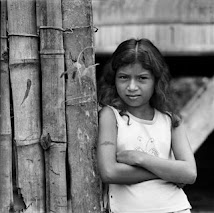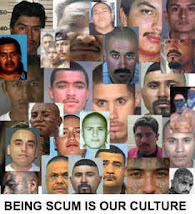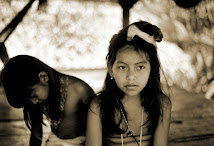







Cofán are among the oldest indigenous cultures survive in the Ecuadorian Amazon. We share our home with the primary forest, wild and pristine rivers and thousands of species of plants and animals, making it achieve one of the most biologically diverse in the world. The approximately one thousand Cofán remaining are the guardians of many valuable and irreplaceable knowledge and more than 400,000 hectares of ancestral land in the heart of the "hotspot" located in the tropical Andes. Most of this land is protected by international agreements and national indigenous territory and under the National System of Protected Areas in Ecuador. Our forests are not only essential for the survival of the Cofan nationality as a people and culture but also as a vital environmental legacy for Ecuador and the world. We live in ten communities throughout the Amazon region in northeastern Ecuador. Historically, we have fought hard to protect our territory and to preserve our culture. The communities that thrive today have survived attempts at colonization, first by the Spaniards and most recently the oil companies that discovered oil sources that were below our territory. They crossed paths opened destroying our forests places important to us. Despite the legal protection that the area has remained under constant threat from hunting, fishing, the logging activities hidrocarbuferias and illegal colonization. We are dedicated to preserving our culture through the preservation of our ancestral lands. Our efforts are aimed at ensuring our rights on this earth to ensure their protection and conservation. Without a home, the people and the Cofan culture can not survive. |
.jpg)

.jpg)
The enslavement, torture, murder, and extermination of the native people of the West Indies followed quickly on the heels of Columbus and his men. It was obvious from Columbus’s journal that the Tainos were not as used to battle and warfare as the Spaniards. Columbus notes that “with 50 men you could subject everyone and make them do what you wished” and that the natives were “such cowards and so fearful” that they were, therefore, easy to rule. This idea was carried back to Europe, setting the tone for the relationship between the natives and the European explorers.
The search for gold was the primary cause for the mistreatment of the native people. On one of Columbus’s later voyages he ordered his men to complete certain tasks to ensure their survival as a colony. His men, however, disliked such hard labor and refused to act. When Columbus returned a few months later to find things worse than when he left, he punished the natives for the failure of his own men. He blamed them for destroying the settlers’ property, stealing their food, and instilling fear. In retaliation for these acts, few—if any—of which had actually occurred, he had his men round up over 1,500 Taino men, women, and children, then forced the Tainos into slavery.
The death and destruction of millions of people and their cultures has led to a lack of evidence about their lives. Researchers have been hard-pressed to find credible and complete relics of the Taino past. The most solid evidence we have which can provide insight into the lives and conditions of the Taino people is from the Spanish. Through Columbus, las Casas, and others historians are able to piece together an often incomplete picture of life on the islands. The recent discoveries of long-forgotten villages in the Antilles have uncovered pieces of pottery, remains of dwellings, zumis, and batey courts which give researchers a first-hand look at Taino life. The other way in which the history of these extinct people can be shared today is through the oral traditions of present-day native people. Although currently no government recognizes an official Taino group, people who say they are descendants of the early Taino are beginning to reclaim their culture. Through the telling and retelling of stories, fables, legends, and myths the customs and cultures of the early Taino and their island brethren live on. It is the legacy of the first inhabitants of the Americas.


"Gold is most excellent; gold constitutes treasure; and he who has it does all he wants in the world, and can even lift souls up to Paradise."
-- Christopher Columbus, 1503 letter to the king and queen of Spain.
"Christopher Columbus not only opened the door to a New World, but also set an example for us all by showing what monumental feats can be accomplished through perseverance and faith."
--George H.W. Bush, 1989 speech
If you fly over the country of Haiti on the island of Hispaniola, the island on which Columbus landed, it looks like somebody took a blowtorch and burned away anything green. Even the ocean around the port capital of Port au Prince is choked for miles with the brown of human sewage and eroded topsoil. From the air, it looks like a lava flow spilling out into the sea.
The history of this small island is, in many ways, a microcosm for what's happening in the whole world.
When Columbus first landed on Hispaniola in 1492, virtually the entire island was covered by lush forest. The Taino "Indians" who loved there had an apparently idyllic life prior to Columbus, from the reports left to us by literate members of Columbus's crew such as Miguel Cuneo.
When Columbus and his crew arrived on their second visit to Hispaniola, however, they took captive about two thousand local villagers who had come out to greet them. Cuneo wrote: "When our caravels... where to leave for Spain, we gathered...one thousand six hundred male and female persons of those Indians, and these we embarked in our caravels on February 17, 1495...For those who remained, we let it be known (to the Spaniards who manned the island's fort) in the vicinity that anyone who wanted to take some of them could do so, to the amount desired, which was done."
Cuneo further notes that he himself took a beautiful teenage Carib girl as his personal slave, a gift from Columbus himself, but that when he attempted to have sex with her, she "resisted with all her strength." So, in his own words, he "thrashed her mercilessly and raped her."
While Columbus once referred to the Taino Indians as cannibals, a story made up by Columbus - which is to this day still taught in some US schools - to help justify his slaughter and enslavement of these people. He wrote to the Spanish monarchs in 1493: "It is possible, with the name of the Holy Trinity, to sell all the slaves which it is possible to sell...Here there are so many of these slaves, and also brazilwood, that although they are living things they are as good as gold..."
Columbus and his men also used the Taino as sex slaves: it was a common reward for Columbus' men for him to present them with local women to rape. As he began exporting Taino as slaves to other parts of the world, the sex-slave trade became an important part of the business, as Columbus wrote to a friend in 1500: "A hundred castellanoes (a Spanish coin) are as easily obtained for a woman as for a farm, and it is very general and there are plenty of dealers who go about looking for girls; those from nine to ten (years old) are now in demand."


Native Americans (also Aboriginal Peoples, Aboriginal Americans, American Indians, Amerindians, Amerind, Indians, First Nations, First Peoples, Native Canadians, or Indigenous Peoples of America) are those peoples indigenous to the Americas, living there prior to European colonization. This term encompasses a large number of distinct tribes, states, and ethnic groups, many of them still enduring as political communities.
The terms "Amerindian" and "Indian", both of which are derivatives of "American Indian" (as is "Amerind", though this term is more popular in linguistic circles), are not necessarily completely synonymous with "Native American". Although all Amerindians are Native Americans, not all Native Americans are Amerindians. "Amerindian" relates to a mega-group of people spanning the Americas that are related in culture and genetics, and are quite distinct from the later arriving Eskimos (Inuit, Yupik, and Aleut peoples native to Alaska and arctic Canada). The latter share their cultural and genetic commonality with other arctic peoples not native to the American continent, such as those from arctic Russian Siberia.
The same distinction is made in Canada, where the term First Nations applies only to Native Canadians who belong to the same cultural and genetic mega-group of Amerindians mentioned above. The Canadian First Nations specifically exclude the Inuit and Inuvialuit in the north, although these are included in the terms "First Peoples" and "Native Canadians". First Peoples are enshrined in the Canadian Constitution with various treaty rights, some long established and many more currently under negotiation.
The term Native American may be construed to either include or exclude the Metis of Canada and the Mestizos and Zambos of Latin America.
Based on anthropological and genetic evidence, scientists generally agree that most Native Americans descend from people who migrated from Siberia across the Bering Strait, between 17,000 11,000 years ago.
The European colonization of the Americas forever changed the lives and cultures of the Native Americans. In the 15th to 19th centuries, their populations were ravaged, by the privations of displacement, by disease, and in many cases by warfare with European groups and enslavement by them. The first Native American group encountered by Columbus, the 250,000 Arawaks of Haiti, were enslaved. Only 500 survived by the year 1550, and the group was extinct before 1650.
In the 15th century Spaniards and other Europeans brought horses to the Americas. Some of these animals escaped and began to breed and increase their numbers in the wild. Ironically, the horse had originally evolved in the Americas, but the last American horses, (species Equus Scotti and others) died out at the end of the last ice age. The re-introduction of the horse had a profound impact on Native American culture in the Great Plains of North America. This new mode of travel made it possible for some tribes to greatly expand their territories, exchange goods with neighboring tribes, and more easily capture game.
From the outset European colonists had, at best, lived in an uneasy truce with the Native Americans. While the groups sometimes cooperated, the Natives were inexorably displaced from the most favorable land, and frequently resisted this process with violence.Although in recent years it has become popular to assert that Native Americans learned scalping from Europeans, historical evidence suggests that scalping by Native Americans had been practiced long before contact with Europeans.
The first reported case of white men scalping Native Americans took place in New Hampshire colony on February 20, 1725.
Four Nations of the Iroquois Confederacy sided with the British and the Tories in the American Revolutionary War. The colonists were especially outraged by the Wyoming Valley Massacre and the Cherry Valley Massacre, which occurred in 1778.
In the 19th century, the Westward expansion of the United States incrementally expelled large numbers of Native Americans from vast areas of their territory, either by forcing them into marginal lands farther and farther west, or by outright massacres. U
nder President Andrew Jackson, Congress passed the Indian Removal Act of 1830, which forced the Five Civilized Tribes from the east onto western reservations, primarily to take their land for settlement. The forced migration was marked by great hardship and many deaths. Its route is known as the Trail of Tears.
On January 31, 1876 the United States government ordered all remaining Native Americans to move into reservations or reserves. This, together with the near-extinction of the American Bison which many tribes had lived on, set about the downturn of Prairie Culture that had developed around the use of the horse for hunting, travel and trading.
Current Status
Military defeat, cultural pressure, confinement on reservations, forced cultural assimilation, outlawing of native languages and culture, forced sterilizations, termination policies of the 1950s, and 1960s, and slavery have had deleterious effects on Native Americans' mental and physical health. Contemporary health problems include poverty, alcoholism, heart disease, diabetes, and New World Syndrome.
As recently as the 1960s, Indians were being jailed for teaching their traditional beliefs. As recently as the 1970s, the Bureau of Indian Affairs was still actively pursuing a policy of "assimilation", the goal of which was to eliminate the reservations and steer Indians into mainstream U.S. culture. Even their lands are perhaps no longer safe; as of 2004, there are still claims of theft of Indian land for the coal and uranium it contains.

The number of Ecuadorians illegally entering the US by
sea has surpassed the number of Cuban boat people or illegal Hatian immigrants,
according to a recent study by the US Embassy in Quito, Ecuador. The
source of the problem is that the Ecuadorian government is not funding
any resources to stop this wave of emigration, as they do not
give it priority in their budget and military planning.
The Ecuadorian immigrants have thus become protagonists of the largest
wave of maritime ilegal immigration in modern history, according to the
Embassy.
Since the year 2000, between 234,000 and 350,000 Ecuadorians have set
sail for Guatamala in illegal embarcations, from where they are smuggled
across the Mexican border and into the US by "coyotesm" according to
the study by Terry S. Wichert, Naval Attache, and Leiutenant Coronel
Michael Trevett.
This surprising figure is twice the previous record for Cuban boat people
(in 1980 124.776 people left Cuba) and is ten times greater than the
numbers of Haitianos (25.177, between1993 y 1994) attempting to enter
by sea.
It has been largely a silent migration, according to the authors, as
the international media have given little or no attention to this migratory
crisis, while for the Ecuadorian press it has become a routine story.
The mass Ecuadorian emigration began in 1999, shortly after a banking
crisis caused millions to lose their life savings, and continues to grow.
"We know that between 4 and 7 ships leave every week, with between 100
and 150 people on each one," according to the embassy.
From the old fishing
boats that set out each week from dozens of Ecuadorian beaches, it
is common to find not only Ecuadorians, but Peruvians, Albanians,
Chinese, Iraquis, Koreans and even Irishmen. The route of illegal immigration
from Ecuador is "so succesful that, frankly, it has gained international
fame. Around the world it is said that if you want to sneak into the
United States, go to Ecuador and get on a ship," according to the report.
The Embassy report adds that some of the ships that carry illegals also
transport drugs, and that the profits from the sales of these drugs reach
the Colombian guerillas. Sometimes the ships return from Central America
carrying arms and munitions.


People of African origin probably first arrived in the Americas with the Spanish and Portuguese in the 15th and 16th centuries. For example, Pedro Alonso Niño, traditionally considered the first of many New World explorers of African descent was a navigator in the 1492 Columbus expedition. Those who were directly from Africa mostly arrived in Latin America as part of the Atlantic slave trade, as agricultural, domestic, and menial laborers and as mineworkers. They were also employed in mapping and exploration (for example, Estevanico) and were even involved in conquest (for example, Juan Valiente). They were mostly brought from West Africa and Central Africa in what are now the nations of Nigeria, Ghana, Benin, Angola, and Congo, There are three major groups: the Yoruba, Akan, and the Bantu.
An Afro-Latin American (also Afro-Latino) is a Latin American person of at least partial Black African ancestry; the term may also refer to historical or cultural elements in Latin America thought to emanate from this community.The term can refer to the mixing of African and other cultural elements found in Latin American society such as religion, music, language, the arts and social class.
The term Afro-Latin American, as used in this article refers specifically to black African ancestry and not to European colonial orAfro-Arab ancestry, such as Arab Moroccan or white South African ancestry. The term is not widely used in Latin America outside of academic circles. Normally Afro Latin Americans are called "black" (in Spanish negro, in Portuguese negro or preto). More commonly, when referring to cultural aspects of African origin within specific countries of Latin America, terms carry an Afro- prefix followed by the relevant nationality. however, usage varies considerably from nation to nation.
The accuracy of statistics reporting on Afro-Latin Americans has been questioned, especially where they are derived from census reports in which the subjects choose their own designation, due to the fact that in all countries the concept of black ancestry is viewed with differing attitudes.
Of a total Latin American population of 549,549,000, an estimated 100-150 million are Afro Latin-American. Approximately 5% of the Latin American population self-identify, or are classified by census takers, as being primarily of black ancestry. A further 16% of the population is mulatto, while Zambos are a smaller minority.
Contentious issues
Several issues arise from the theme of African Latin American. One is based on the selection of countries normally included in the definition of Latin America which, being based on the language spoken, excludes all countries in the geographical area, such as Suriname, Trinidad and Tobago, and Jamaica where the people do not speak a Latin-derived language. As a result, several countries which have significant black heritage are excluded from study





Illegal immigrants are responsible for 12 murders every day compared to 1.7 soldiers killed daily in Iraq.






















.jpg)




.jpg)

Hispanics, otherwise known as spics and beaners, are a vast and terrible infection. This plague has infiltrated every aspect of America and soon will continue to destroy life in any and every form that we currently recognize.
This pestilence may be even greater and farther reaching than the bubonic plague was centuries ago. This simple fact has resulted in the beaner swarm's well known accolade: La Muerte Castaño, A.K.A. "The Brown Death".
Spics' bodies are generally considered to be an abomination of the human form. They are short, stubby, useless hunks of flesh and bone which are wrapped in a disgusting shit-brown elastic substance.
The Spic genus shares many aspects with numerous other animals that somewhat resemble their evolutionary pathways. The earthworm for instance, is a simple creature which only has the objective to consume and breed. Spics are quite similar to this creature with the only difference being that while the earthworm may be useful for creating soil nutrients, beaners are useful for nothing but mowing lawns.
Spics' ancestors include horny Spanish conquistadors, various and sundry animals, and a legion of extremely primitive spider/monkey humanoids who ran nude in the this to be truth since how the beaners share so many characteristics with the said insect family.
The latest mutagen of the Spic species, known as both the "Border Jumper" and the more fitting "Illegal Alien", has finally consumed all the available produce and nutrients in its once-lush jungle homeland of Mexico. This event has pushed the insidious plague further north into the peopled lands of the USA and Canada.
Today, spics carry on a proud tradition of being slaves to their white masters. This has been a most fortunate thing for business, which has suffered since Abe "Hitler" Lincoln said people couldn't own niggers anymore. Most of them make tolerable cooks, landscapers, or basic manual laborers. W, in yet another fail move of his insane presidential strategystarted to call attention to the over 9000 spics crawling across the border like army ants.




